金融学课后答案
金融学概论课后习题答案
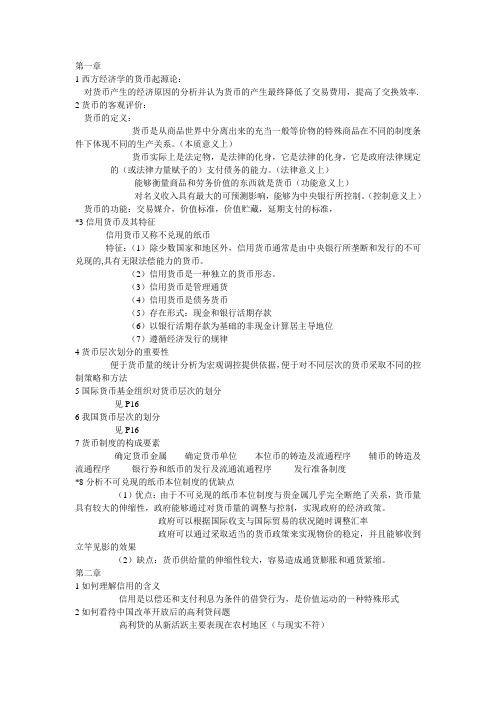
第一章1西方经济学的货币起源论:对货币产生的经济原因的分析并认为货币的产生最终降低了交易费用,提高了交换效率. 2货币的客观评价:货币的定义:货币是从商品世界中分离出来的充当一般等价物的特殊商品在不同的制度条件下体现不同的生产关系。
(本质意义上)货币实际上是法定物,是法律的化身,它是法律的化身,它是政府法律规定的(或法律力量赋予的)支付债务的能力。
(法律意义上)能够衡量商品和劳务价值的东西就是货币(功能意义上)对名义收入具有最大的可预测影响,能够为中央银行所控制。
(控制意义上)货币的功能:交易媒介,价值标准,价值贮藏,延期支付的标准,*3信用货币及其特征信用货币又称不兑现的纸币特征:(1)除少数国家和地区外,信用货币通常是由中央银行所垄断和发行的不可兑现的,具有无限法偿能力的货币。
(2)信用货币是一种独立的货币形态。
(3)信用货币是管理通货(4)信用货币是债务货币(5)存在形式:现金和银行活期存款(6)以银行活期存款为基础的非现金计算居主导地位(7)遵循经济发行的规律4货币层次划分的重要性便于货币量的统计分析为宏观调控提供依据,便于对不同层次的货币采取不同的控制策略和方法5国际货币基金组织对货币层次的划分见P166我国货币层次的划分见P167货币制度的构成要素确定货币金属确定货币单位本位币的铸造及流通程序辅币的铸造及流通程序银行券和纸币的发行及流通流通程序发行准备制度*8分析不可兑现的纸币本位制度的优缺点(1)优点:由于不可兑现的纸币本位制度与贵金属几乎完全断绝了关系,货币量具有较大的伸缩性,政府能够通过对货币量的调整与控制,实现政府的经济政策。
政府可以根据国际收支与国际贸易的状况随时调整汇率政府可以通过采取适当的货币政策来实现物价的稳定,并且能够收到立竿见影的效果(2)缺点:货币供给量的伸缩性较大,容易造成通货膨胀和通货紧缩。
第二章1如何理解信用的含义信用是以偿还和支付利息为条件的借贷行为,是价值运动的一种特殊形式2如何看待中国改革开放后的高利贷问题高利贷的从新活跃主要表现在农村地区(与现实不符)3商业信用的局限性规模上的局限性方向上的局限性期限上的短期性管理上的困难性4银行信用的优点规模上的无限性方向上的无限性期限上的可选择性管理上的便利性5银行信用的作用调剂政府财政收支的临时不平衡弥补财政赤字筹集资金调节经济运行6信用消费的作用在社会总供给大于社会总需求,经济处于萧条阶段的情况下,消费信用能够发挥积极作用;在社会总供给小于社会总需求时,消费过旺,经济过热,信用消费可能加剧市场供求的紧张形势推动物价上涨,造成通货膨胀。
2020年智慧树知道网课《金融学》课后习题章节测试满分答案

绪论单元测试1【判断题】(20分)间接融资是指资金供求双方通过商业银行等金融中介机构而间接融通资金。
在间接融资方式下,资金短缺单位与盈余单位并不发生直接的融资关系,而是通过银行等金融中介机构发生间接的融资关系。
A.对B.错2【多选题】(20分)金融体系的构成要素一般包括:A.金融制度B.金融工具C.金融市场D.金融机构3【多选题】(20分)金融资产具有的两个重要经济功能是:A.提供流动性功能B.资源配置功能C.风险转移功能D.提供信息功能4【判断题】(20分)从广义角度的金融创新来看,一部金融发展史就是一部金融创新的历史。
A.对B.错5【判断题】(20分)金融机构是金融交易活动的中介和金融体系的核心,是金融体系运行的组织者、推动者和管理者。
A.对B.错第一章测试1【单选题】(20分)从铸币时期开始,金属货币不再具有一般实物货币的基本属性,主要表现是因为()。
A.铸币的标准化B.名义价值和实际价值开始相分离C.国家信用成为载体D.运输成本下降2【单选题】(20分)综合物价指数上涨了25%,则货币购买力指数会()。
A.下降20%B.下降25%C.上涨25%D.上涨20%3【多选题】(20分)曾被人们誉为最理想的货币制度的金币本位制之所以崩溃的原因在于()。
A.金币不可以自由输出入国境B.黄金储量与产量难以维持经济发展对货币数量的要求C.金币失去自由铸造和自由熔化的前提D.黄金存量的分布不均4【判断题】(20分)银行券是银行发行的以其自身为债务人的债权债务凭证,早期作为最主要的一种代用货币可以随时兑现为金属货币,后来发展成为不可兑现的信用货币,但是其一直都是足值的货币。
A.错B.对5【单选题】(20分)在货币层次中M是指()。
A.回笼的现金B.流通中的现金C.贮藏的现金D.投放的现金第二章测试1【单选题】(20分)信用是:A.赠予行为B.买卖行为C.救济行为D.各种借货关系的总和2【单选题】(20分)利用信用卡透支属于:A.消费信用B.商业信用C.银行信用D.国家信用3【单选题】(20分)西方国家所说的基准利率,一般是指中央银行的:A.贷款利率B.存款利率C.市场利率D.再贴现利率4【单选题】(20分)名义利率与物价变动率的关系是:A.交叉相关关系B.负相关关系C.正相关关系D.无相关关系5【多选题】(20分)可贷资金利率决定理论认为,利率决定于:A.货币供给B.投资C.货币需求D.储蓄第三章测试1【单选题】(20分)下列不属于我国相关规定的外汇范畴的是()。
金融学(刘玉平)-课后部分简答题答案
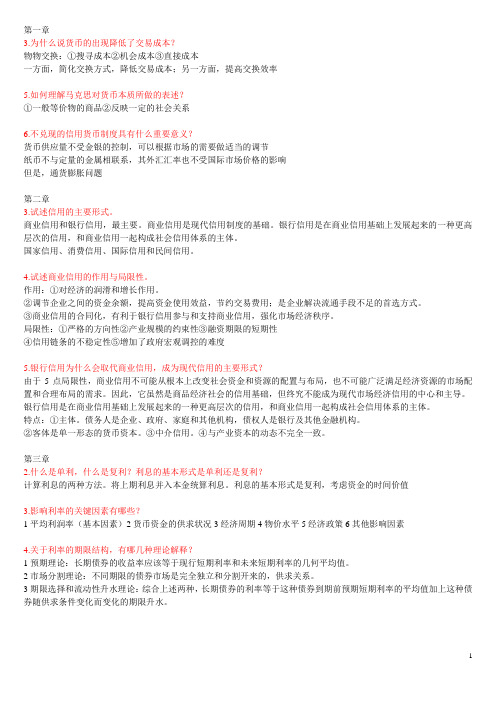
第一章3.为什么说货币的出现降低了交易成本?物物交换:①搜寻成本②机会成本③直接成本一方面,简化交换方式,降低交易成本;另一方面,提高交换效率5.如何理解马克思对货币本质所做的表述?①一般等价物的商品②反映一定的社会关系6.不兑现的信用货币制度具有什么重要意义?货币供应量不受金银的控制,可以根据市场的需要做适当的调节纸币不与定量的金属相联系,其外汇汇率也不受国际市场价格的影响但是,通货膨胀问题第二章3.试述信用的主要形式。
商业信用和银行信用,最主要。
商业信用是现代信用制度的基础。
银行信用是在商业信用基础上发展起来的一种更高层次的信用,和商业信用一起构成社会信用体系的主体。
国家信用、消费信用、国际信用和民间信用。
4.试述商业信用的作用与局限性。
作用:①对经济的润滑和增长作用。
②调节企业之间的资金余额,提高资金使用效益,节约交易费用;是企业解决流通手段不足的首选方式。
③商业信用的合同化,有利于银行信用参与和支持商业信用,强化市场经济秩序。
局限性:①严格的方向性②产业规模的约束性③融资期限的短期性④信用链条的不稳定性⑤增加了政府宏观调控的难度5.银行信用为什么会取代商业信用,成为现代信用的主要形式?由于5点局限性,商业信用不可能从根本上改变社会资金和资源的配置与布局,也不可能广泛满足经济资源的市场配置和合理布局的需求。
因此,它虽然是商品经济社会的信用基础,但终究不能成为现代市场经济信用的中心和主导。
银行信用是在商业信用基础上发展起来的一种更高层次的信用,和商业信用一起构成社会信用体系的主体。
特点:①主体。
债务人是企业、政府、家庭和其他机构,债权人是银行及其他金融机构。
②客体是单一形态的货币资本。
③中介信用。
④与产业资本的动态不完全一致。
第三章2.什么是单利,什么是复利?利息的基本形式是单利还是复利?计算利息的两种方法。
将上期利息并入本金统算利息。
利息的基本形式是复利,考虑资金的时间价值3.影响利率的关键因素有哪些?1平均利润率(基本因素)2货币资金的供求状况3经济周期4物价水平5经济政策6其他影响因素4.关于利率的期限结构,有哪几种理论解释?1预期理论:长期债券的收益率应该等于现行短期利率和未来短期利率的几何平均值。
李健金融学第3版课后习题答案
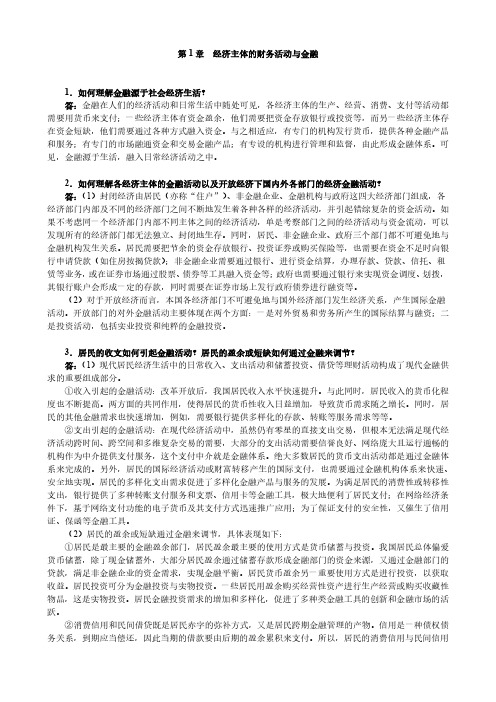
第1章经济主体的财务活动与金融1.如何理解金融源于社会经济生活?答:金融在人们的经济活动和日常生活中随处可见,各经济主体的生产、经营、消费、支付等活动都需要用货币来支付;一些经济主体有资金盈余,他们需要把资金存放银行或投资等,而另一些经济主体存在资金短缺,他们需要通过各种方式融入资金。
与之相适应,有专门的机构发行货币,提供各种金融产品和服务;有专门的市场融通资金和交易金融产品;有专设的机构进行管理和监督,由此形成金融体系。
可见,金融源于生活,融入日常经济活动之中。
2.如何理解各经济主体的金融活动以及开放经济下国内外各部门的经济金融活动?答:(1)封闭经济由居民(亦称“住户”)、非金融企业、金融机构与政府这四大经济部门组成,各经济部门内部及不同的经济部门之间不断地发生着各种各样的经济活动,并引起错综复杂的资金活动。
如果不考虑同一个经济部门内部不同主体之间的经济活动,单是考察部门之间的经济活动与资金流动,可以发现所有的经济部门都无法独立、封闭地生存。
同时,居民、非金融企业、政府三个部门都不可避免地与金融机构发生关系。
居民需要把节余的资金存放银行、投资证券或购买保险等,也需要在资金不足时向银行申请贷款(如住房按揭贷款);非金融企业需要通过银行、进行资金结算,办理存款、贷款、信托、租赁等业务,或在证券市场通过股票、债券等工具融入资金等;政府也需要通过银行来实现资金调度、划拨,其银行账户会形成一定的存款,同时需要在证券市场上发行政府债券进行融资等。
(2)对于开放经济而言,本国各经济部门不可避免地与国外经济部门发生经济关系,产生国际金融活动。
开放部门的对外金融活动主要体现在两个方面:一是对外贸易和劳务所产生的国际结算与融资;二是投资活动,包括实业投资和纯粹的金融投资。
3.居民的收支如何引起金融活动?居民的盈余或短缺如何通过金融来调节?答:(1)现代居民经济生活中的日常收入、支出活动和储蓄投资、借贷等理财活动构成了现代金融供求的重要组成部分。
金融学课后习题解答
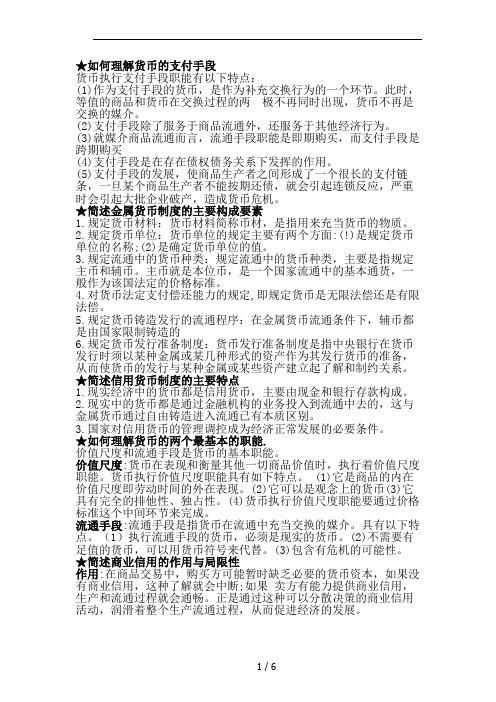
★如何理解货币的支付手段货币执行支付手段职能有以下特点:(1)作为支付手段的货币,是作为补充交换行为的一个环节。
此时,等值的商品和货币在交换过程的两极不再同时出现,货币不再是交换的媒介。
(2)支付手段除了服务于商品流通外,还服务于其他经济行为。
(3)就媒介商品流通而言,流通手段职能是即期购买,而支付手段是跨期购买(4)支付手段是在存在债权债务关系下发挥的作用。
(5)支付手段的发展,使商品生产者之间形成了一个很长的支付链条,一旦某个商品生产者不能按期还债,就会引起连锁反应,严重时会引起大批企业破产,造成货币危机。
★简述金属货币制度的主要构成要素1.规定货币材料:货币材料简称币材,是指用来充当货币的物质。
2.规定货币单位:货币单位的规定主要有两个方面:(!)是规定货币单位的名称;(2)是确定货币单位的值。
3.规定流通中的货币种类:规定流通中的货币种类,主要是指规定主币和辅币。
主币就是本位币,是一个国家流通中的基本通货,一般作为该国法定的价格标准。
4.对货币法定支付偿还能力的规定,即规定货币是无限法偿还是有限法偿。
5.规定货币铸造发行的流通程序:在金属货币流通条件下,辅币都是由国家限制铸造的6.规定货币发行准备制度:货币发行准备制度是指中央银行在货币发行时须以某种金属或某几种形式的资产作为其发行货币的准备,从而使货币的发行与某种金属或某些资产建立起了解和制约关系。
★简述信用货币制度的主要特点1.现实经济中的货币都是信用货币,主要由现金和银行存款构成。
2.现实中的货币都是通过金融机构的业务投入到流通中去的,这与金属货币通过自由铸造进入流通已有本质区别。
3.国家对信用货币的管理调控成为经济正常发展的必要条件。
★如何理解货币的两个最基本的职能.价值尺度和流通手段是货币的基本职能。
价值尺度:货币在表现和衡量其他一切商品价值时,执行着价值尺度职能。
货币执行价值尺度职能具有如下特点。
(1)它是商品的内在价值尺度即劳动时间的外在表现。
金融学精编版课后答案

金融学精编版课后答案第一章:导论1.金融学的定义是什么?金融学是研究资金在时间上的配置和风险管理的学科,涉及资金的获取、分配和使用。
它研究金融体系、金融机构以及金融工具和市场的运作。
2.什么是金融体系?金融体系是由金融机构、金融市场和金融工具组成的系统。
它提供资金流动、风险管理和货币流通等功能,促进了经济的发展。
3.金融工具有哪些分类?金融工具可以分为债务类金融工具和权益类金融工具。
债务类金融工具包括债券和贷款,权益类金融工具包括股票和衍生品。
4.金融市场有哪些分类?金融市场可以分为证券市场、货币市场、外汇市场和衍生品市场等。
证券市场用于买卖股票和债券,货币市场用于短期资金借贷,外汇市场用于买卖不同货币,衍生品市场用于交易期权和期货等金融衍生品。
5.金融学的核心问题是什么?金融学的核心问题是资金的配置和风险管理。
资金的配置涉及如何选择投资项目以及如何融资,风险管理则涉及如何评估和管理投资和融资的风险。
第二章:时间价值与利率1.什么是时间价值?时间价值是指资金在不同时间点的价值不同。
由于时间的价值,资金的未来价值要低于相同金额的当前价值。
2.为什么时间价值是重要的?时间价值是重要的因为它影响了我们的投资和融资决策。
在投资时,我们希望未来的收益越高越好,因此需要考虑时间价值来评估投资项目的可行性。
在融资时,我们希望以尽可能低的利率获得资金,而利率受时间价值影响。
3.什么是利率?利率是资金使用的价格,表示资金的时间价值。
它通常以百分比的形式表示,并表示为每年的利率。
4.利率的决定因素有哪些?利率的决定因素包括货币政策、通货膨胀预期、风险溢价和市场供求关系等。
货币政策决定了货币的供给量以及利率的总体水平,通货膨胀预期影响了实际利率,风险溢价反映了借款方的风险偏好,市场供求关系决定了市场利率。
5.什么是复利?复利是指利息再投资产生的利息。
与简单利率不同,复利可以使资金在一段时间内获得更高的回报。
第三章:风险与收益1.风险和收益之间存在什么样的关系?风险和收益之间存在正相关关系,即风险越高,预期收益也越高。
《金融学》课后答案

第一章货币与货币制度1.钱、货币、通货、现金是一回事吗?银行卡是货币吗?答:(1)钱、货币、通货、现金不是一回事,虽然其内容有所重叠,但这几个概念之间是有区别的。
钱是人们对货币的俗称。
经济学中被称为货币的东西,就是在日常人们生活中被称为钱的东西。
货币是由国家法律规定的,在商品劳务交易中或债务清偿中被社会普遍接受的东西。
通货即流通中的货币,指流通于银行体系外的货币。
现金就是指家庭个人、工商企业、政府部门所拥有的现钞,包括纸币现钞、硬币现钞。
现金是货币的一部分,这部分货币的流动性强,使用频率高,对人们日常消费影响大。
(2)银行卡亦称“塑料货币”,是由银行发行,供客户办理存取款等业务的新型服务工具的总称,包括信用卡、支票卡、记账卡、自动出纳机卡、灵光卡等。
各种银行卡是用塑料制作的,可用于存取款和转账支付。
现在,特别在西方发达国家,各种银行卡正逐步取代现钞和支票,成为经济生活中广泛运用的支付工具。
因此,在现代社会银行卡也属于货币。
2.社会经济生活中为什么离不开货币?为什么自古至今,人们又往往把金钱看作是万恶之源?答:(1)社会经济生活离不开货币,货币的产生和发展都有其客观必然性。
物物交换的局限性要求有某种商品充当共同的、一般的等价物,而金银的特性决定其成为货币的天然材料。
作为货币的金银等贵金属,便于携带、铸造和分割,大大推动了商品经济的发展。
随着经济的发展,货币形态不断发生变化。
经历了实物货币阶段、贵金属货币阶段、代用货币阶段和信用货币阶段。
当今货币正朝着专门化、无体化、扩张化、电子化的趋势发展。
但不管货币的具体形态如何,都是媒介商品经济所必需的。
对货币的使用是实现市场对资源合理配置的必要条件,也是市场经济正常运行的必要条件。
从这个意义上说,市场经济实际上是一种货币经济:货币方便了市场交换,提高了市场效率;货币保证了社会需求的实现,促进了市场对资源的有效配置。
从交易成本上看,节约是经济生活中最基本的规律。
金融学课后题答案高教版

金融学课后题答案一、名词解释第一章1、货币:是从商品世界分离出来的固定充当一般等价物的特殊商品,能反映一定的生产关系,即人与人之间的劳动交换的相互关系。
2、信用货币:以信用为保证,通过一定信用程序发行,充当流通手段与支付手段的货币形态,是货币的现代形态。
(分为辅币、纸币、存款货币)3、电子货币:在零售支付机制中,通过销售终端,不同电子设备之间以及在公开网络上执行支付的“储值”或“预付支付机制”。
4、货币制度:又称“币制”或“货币本位制”,是指一个国家用法律规定该国货币的流通结构和组织形式。
5、格雷欣法则:在双本位制下,由于法定比价与市场比价不一致,市价比法定价格高的金属货币(良币)在流通中数量逐渐减少,市价比法定价格低的金属货币(劣币)在流通中的数量逐渐增加(劣币驱逐良币),导致货币流通不稳定的现象。
6、信用货币制度:(管理货币本位)由中央银行代表国家发行以国家信用为基础的信用货币作为本币,由政府赋予本位币无限法偿能力并通过银行信用程序进入流通的货币制度。
7、货币替代:在一国经济发展过程中,居民因对本国货币的比值稳定失去信心或本国货币资产收益相对较低是发生大规模货币兑换,从而外币在价值储存、交易媒介和计价标准等货币职能方面全面或部分的替代本币发挥作用的一种现象。
8、特里芬难题:以单一国别货币充当世界货币时,该种货币将面临的保持币值稳定和提供充分的国际清偿力之间的矛盾。
9、货币层次划分:把流通中的货币量,按照其流动性的大小分成若干层次,从而界定货币构成范围的一种方法。
10、货币流通:指货币作为流通手段和支付手段形成的连续不断的运动。
第二章1、利率:指借贷期内所形成的利息额与所贷资金额的比率。
2、货币时间价值:指货币经历一定时间的投资和再投资所增加的价值。
3、现值:又称本金,是指未来货币的现在价值。
4、终值:又称本利和,是指资金经过若干时期后,包括本金和时间价值在内的未来价值。
5、利率体系:在一个经济运行机体中存在的各种利息率由各种内在因素联结成的有机体,主要包括利率体系结构和各种利率间的传导机制。
金融学课后习题参考答案
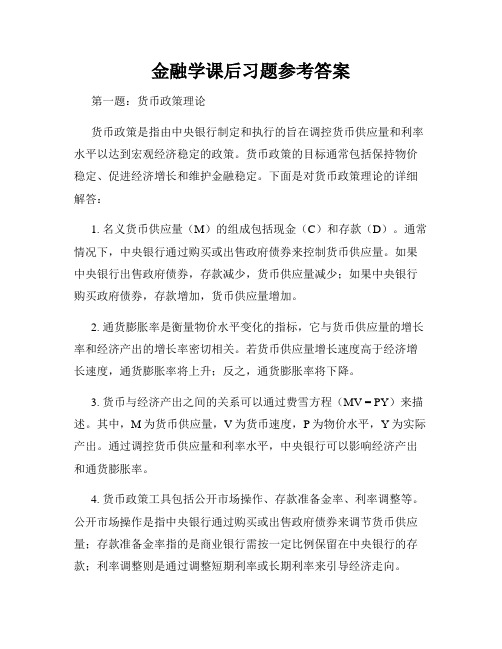
金融学课后习题参考答案第一题:货币政策理论货币政策是指由中央银行制定和执行的旨在调控货币供应量和利率水平以达到宏观经济稳定的政策。
货币政策的目标通常包括保持物价稳定、促进经济增长和维护金融稳定。
下面是对货币政策理论的详细解答:1. 名义货币供应量(M)的组成包括现金(C)和存款(D)。
通常情况下,中央银行通过购买或出售政府债券来控制货币供应量。
如果中央银行出售政府债券,存款减少,货币供应量减少;如果中央银行购买政府债券,存款增加,货币供应量增加。
2. 通货膨胀率是衡量物价水平变化的指标,它与货币供应量的增长率和经济产出的增长率密切相关。
若货币供应量增长速度高于经济增长速度,通货膨胀率将上升;反之,通货膨胀率将下降。
3. 货币与经济产出之间的关系可以通过费雪方程(MV = PY)来描述。
其中,M为货币供应量,V为货币速度,P为物价水平,Y为实际产出。
通过调控货币供应量和利率水平,中央银行可以影响经济产出和通货膨胀率。
4. 货币政策工具包括公开市场操作、存款准备金率、利率调整等。
公开市场操作是指中央银行通过购买或出售政府债券来调节货币供应量;存款准备金率指的是商业银行需按一定比例保留在中央银行的存款;利率调整则是通过调整短期利率或长期利率来引导经济走向。
第二题:投资组合理论投资组合理论是指通过合理配置不同资产的比例和权重,以降低风险并提高收益的投资策略。
下面是对投资组合理论的详细解答:1. 投资组合的关键是在不同的资产之间寻求相关性较小或负相关的资产以降低系统风险。
相关性较小的资产可以互相抵消风险,从而提高组合的整体表现。
2. 投资者可以通过构建有效前沿曲线来选择最优投资组合。
有效前沿曲线代表了在给定风险水平下,可以获得的最大收益。
投资者可以在有效前沿曲线上选择适合自己风险偏好的投资组合。
3. 马科维茨提出了资本资产定价模型(CAPM),该模型可以帮助投资者确定资产的预期收益率。
CAPM模型认为,资产的预期收益率与市场风险有关,市场风险可以通过贝塔系数来度量。
金融学课后答案

金融学课后答案What is a classic? It takes about 100 years to become a classic.Chapter1一.名词解释1.价值尺度:价值尺度是指货币赋予交易对象以价格形态的职能;2.无限法偿:无限法偿是指法律规定的无限制偿付能力,其含义是:法律保护取得这种能力的货币,不论每次支付数额多大,不论属于何种性质的支付,即不论是购买商品、支付服务、结清债务、缴纳税款等,支付的对方均不得拒绝接受;3.一般等价物一般等价物是指从商品中分离出来的充当其他一切商品的统一价值表现的商品,它的出现是商品生产和交换发展的必然结果;4.信用货币信用货币又称不兑现纸币,是指货币本身价值低于货币价值,而且不能兑换成贵金属的货币;5.货币流动性货币流动性是指不同的信用工具在市场上能够转化为直接支付能力的速度和方便程度;流动性高,即转化为直接支付能力的能力强;流动性低,即转化为直接支付能力的弱;二.判断题1.有限法偿只要是对本位币规定的,其含义是:在一次支付行为中,超过一定的金额,收款人有权拒收;在法定限额内,拒收则不受法律保护;错有限发偿主要是对辅币规定2.金属货币制发挥蓄水池功能的前提是要有足够大的币材金属贮藏;对3.铸造重量大、成色好的铸币是古代货币流通中反复发生的行为;错铸造重量轻,成色差的4.把各国不同货币的购买力加以比较,即可比出名称不同的货币单位相互之间的比值;对5.本位币的面值大多是辅币的1/10、1/100.错辅币的是本位币的1/10、1/100.6.强调货币的存在乃客观经济生活发展的必然,是通向认识本质的正确思路;循着这条思路,马克思用最完整的劳动价值论对货币产生的论证有划时代的意义;对7.银行券是一种信用货币;对8.香港特别行政区实行外汇管制;错回归后不实行外汇管制三.不定项选择题1.中国最早的铸币金属是AA铜B银C铁D贝2.在生活中,会用到的货币有ABCDA家庭与个人B公司、企业C非营利性的机关、团体D财政3.在我国的货币层次划分中,M2等于M1与准货币的加总,准货币包括CA长期存款B短期存款C长短期存款之和D公众持有的现金4.纸币的发行是建立在货币B职能的基础上的;A价值尺度B流通手段C支付手段D储藏手段5.在信用活动中,货币发挥的职能通常是BA储藏手段B支付手段C流通手段D价值尺度6.作为流通手段职能的货币是BA价值符号B现实的货币C信用货币D观念上的货币7.金本位制度下,汇价的基本决定因素是AA铸币平价B商品的价格C货币购买力D物价指数8.经济对货币的需求包括对BCA储藏手段的需求B流通手段的需求C支付手段的需求D世界货币的需求9.货币所具有的特征是ACDA表现商品价值B在世界范围内流通C衡量商品价值D与一切商品相交换10.我国的人民币制度属于DA金本位制B银本位制C金银复本位制D不兑现信用货币制度11.下列哪项说法不属于法定货币的特征DA可代替金属货币B代表是指商品或货物C发行者无将其兑现为实物的义务D不是足值货币12.格雷欣法则起作用于以下哪种货币本位制度BA平行本位制B双本位制C跛行本位制D单本位制13.国内只流通银行券且不能兑换黄金,国际储备除黄金外还有一定比例的外汇,外汇在国外才可兑换黄金,黄金是最后的支付手段,直射D的特点;A金块本位制B金币本位制C金条本位制D金汇兑本位制14.对货币单位的理解正确的有BEA国家法定的货币计量单位B规定了货币单位的名称C规定了本位币的币材D确定技术标准E规定了货币单位所含的货币金属量五.论述1.试论述对货币本质的理解;a对货币本质的理解,许多学说各有论述,观点不一;货币金属主义把货币定义为财富,认为货币就是金属;货币明目主义认为货币是国家创造的价值符号或票券;凯恩斯把货币定义为国家通过法律强制流通的国家创造物等等;这些观点多从经济现象的表面论证货币的本质,虽有一定合理的成分,却缺乏科学的解释;b马克思从货币的起源和逻辑分析的角度认识货币的本质是具有科学性的;马克思认为货币是固定充当一般等价物的特殊商品,他认为货币是一个历史的经济范畴,起源与商品的生产和交换的发展;随着经济社会的发展,从商品内在矛盾的冲突中可以得出交换是解决矛盾的唯一途径;从交换的发展所引起的价值形态演变中可以看出货币是价值形态发展的必然结果;c马克思的货币本质观表明了货币与商品世界的对应关系,这一分析有助于理解货币外在形式的不断变化并不改变货币的本质;2.试论述货币在经济发展中的作用;a赋予交易对象以价格形态,使商品和服务能够相互比较;b货币是商品实现价值的媒介物,现代经济活动中的生产、流通、交换、消费过程都离不开货币的作用;c现代经济是信用经济,实际交易过程发生大量的债券债务关系,货币成为重要的支付手段和结算工具,它对市场的正常运作、债权债务的清偿具有重要作用;d货币也是现代经济发展中储蓄和投资的重要工具;对储蓄资源的分配和投资活动发挥了巨大作用;货币能通过利率机制对投资活动进行刺激,并对国民经济发挥作用;马克思称货币是“经济发展的第一推动力”;。
金融学答案完整版
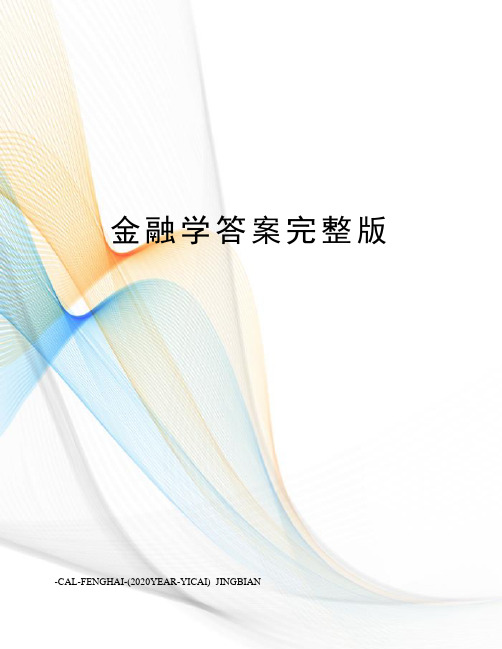
金融学答案完整版-CAL-FENGHAI-(2020YEAR-YICAI)_JINGBIAN名词解释1、格雷欣法则:即两种市场价格不同而法定价格相同的货币同时流通时,市场价格偏高的货币(良币)会被市场价格偏低的货币(劣币)所排斥,在价值规律的作用下,良币退出流通进入贮藏,二劣币充斥市场,这种劣币驱逐良币的现象就是格雷欣法则。
2、商业信用:商业信用是企业之间以赊销、分期付款等形式提供的与商品交易直接联系的信用形式。
3、消费信用:为消费者个人提供的用于满足其消费方面所需货币的信用,是现代经济生活的一种信用形式。
4、银行信用:是指以银行为中介,以存款等方式筹集货币资金,以贷款方式对国民经济各部门、各企业提供资金的一种信用形式。
5、商业汇票:由债权人向债务人发出的支付承诺说,承诺在约定期限支付一定款项给第三人或持票人6、回购协议:证券出售时卖方想买方承诺在未来的某个时间将证券买回的协议。
7、金融衍生工具:是指其价值依赖于原生性金融工具的金融产品。
在形式上均表现为一种合约,在合约上载明买卖双方同意的交易品种、价格、数量、交割时间及地点等。
8、期权合约:指期权的买方有权在约定的时间或约定的时期内,按照约定的价格买进或卖出一定数量的相关资产,也可以根据需要放弃行使这一权利。
9、期货合约:交易双方按约定的价格在未来某一时间完成特定资产交易行为的一种方式。
10、二级市场:有价证券的交易场所、流通市场,是发行的有价证券进行买卖交易的场所。
11、信用工具:亦称融资工具,是资金供应者和资金需求者之间进行资金融通时所签发的证明债权或所有权的各种具有法律效用的凭证12、中央银行:是国家最高的货币金融管理组织机构,在各国金融体系中居于主导地位。
国家赋予其制定和执行货币政策,对国民经济进行宏观调控,对其它金融机构乃至金融业进行监督管理权限,地位非常特殊。
13、存款准备金业务:是指金融机构为保证客户提取存款和资金清算需要而准备的在中央银行的存款,中央银行要求的存款准备金占其存款总额的比例就是存款准备金率(deposit-reserveratio)14、货币需求:企业、家庭个、个人等微观经济主体出于交易、预防或愿以货币形式持有财产等诸种冬季产生对货币的需要量。
金融学课后习题答案

第一章货币与货币制度1.钱、货币、通货、现金是一回事吗?银行卡是货币吗?答:(1)钱、货币、通货、现金不是一回事,虽然其内容有所重叠,但这几个概念之间是有区别的。
钱是人们对货币的俗称。
经济学中被称为货币的东西,就是在日常人们生活中被称为钱的东西。
货币是由国家法律规定的,在商品劳务交易中或债务清偿中被社会普遍接受的东西。
通货即流通中的货币,指流通于银行体系外的货币。
现金就是指家庭个人、工商企业、政府部门所拥有的现钞,包括纸币现钞、硬币现钞。
现金是货币的一部分,这部分货币的流动性强,使用频率高,对人们日常消费影响大。
(2)银行卡亦称“塑料货币”,是由银行发行,供客户办理存取款等业务的新型服务工具的总称,包括信用卡、支票卡、记账卡、自动出纳机卡、灵光卡等。
各种银行卡是用塑料制作的,可用于存取款和转账支付。
现在,特别在西方发达国家,各种银行卡正逐步取代现钞和支票,成为经济生活中广泛运用的支付工具。
因此,在现代社会银行卡也属于货币。
2.社会经济生活中为什么离不开货币?为什么自古至今,人们又往往把金钱看作是万恶之源?答:(1)社会经济生活离不开货币,货币的产生和发展都有其客观必然性。
物物交换的局限性要求有某种商品充当共同的、一般的等价物,而金银的特性决定其成为货币的天然材料。
作为货币的金银等贵金属,便于携带、铸造和分割,大大推动了商品经济的发展。
随着经济的发展,货币形态不断发生变化。
经历了实物货币阶段、贵金属货币阶段、代用货币阶段和信用货币阶段。
当今货币正朝着专门化、无体化、扩张化、电子化的趋势发展。
但不管货币的具体形态如何,都是媒介商品经济所必需的。
货币节省了社会劳动,促进了市场经济的有效率的发展。
对货币的使用是实现市场对资源合理配置的必要条件,也是市场经济正常运行的必要条件。
从这个意义上说,市场经济实际上是一种货币经济:货币方便了市场交换,提高了市场效率;货币保证了社会需求的实现,促进了市场对资源的有效配置。
金融学基础课后练习答案
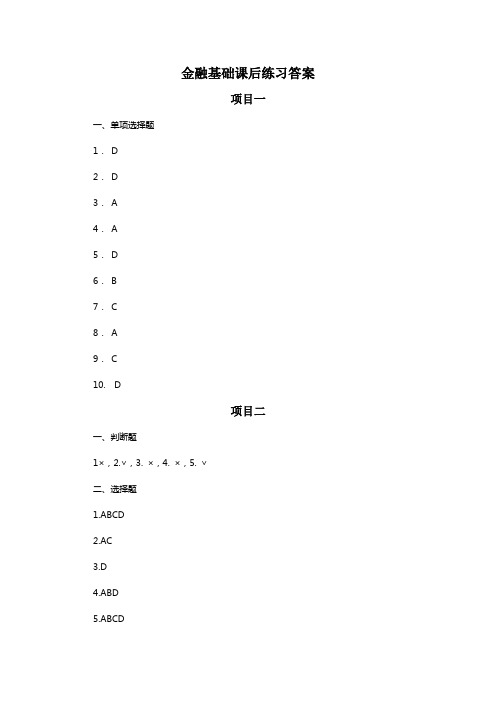
金融基础课后练习答案项目一一、单项选择题1.D2.D3.A4.A5.D6.B7.C8.A9.C10. D项目二一、判断题1×,2.∨,3. ×,4. ×,5. ∨二、选择题1.ABCD2.AC3.D4.ABD5.ABCD6.AD7.CD三、略项目三一、判断题1×2. ×3. ×4. ∨5. ×6. ×7. ×二、选择题1.ACD2.C3.AC4.ABC5.BCD6.D7.ABCD8.ABC9.ABCD三、略项目四金融现象习题答案1、名词解释货币需求:一定时间内,社会各经济主体(如个人、企业和单位等)能够并愿意持有货币的行为。
货币供给:货币供给是指一国经济体系中货币的投入、创造和扩张(或收缩)的过程。
基础货币:基础货币又称强力货币,因其具有使货币供应总量成倍放大或收缩的能力,又被称为高能货币,是指流通领域中为社会公众所持有的现金及银行体系准备金(包括法定准备金和超额准备金)的总和。
货币乘数:货币供给量对基础货币的倍数关系,即基础货币每增加或减少一个单位所引起的货币供给量增加或减少的倍数。
货币均衡:货币均衡是指货币供给与货币需求在总量上基本保持一致的货币流通状态。
若以M d表示货币需求,M s表示货币供给,则货币均衡可表示为:M d = M s通货膨胀:大多数商品和劳务的物价普遍、持续上涨的过程。
通货紧缩:通货紧缩是与通货膨胀相对的概念,具体表现为商品价格的持续下降。
2、判断对错并说明理由(1)货币需求是指一定时间内,社会各经济主体想要持有货币的能力。
(×)(2)凯恩斯的货币需求理论认为,利率过低时,人们预期利率会上升,此时购买债券具有更多的盈利空间,因此选择购买债券,降低手中货币持有量。
(×)(3)商业银行吸收的定期存款没有创造派生存款的能力。
(×)(4)假设基础货币下降3%,货币乘数增加3%,那么货币供应量不变。
金融学课后答案
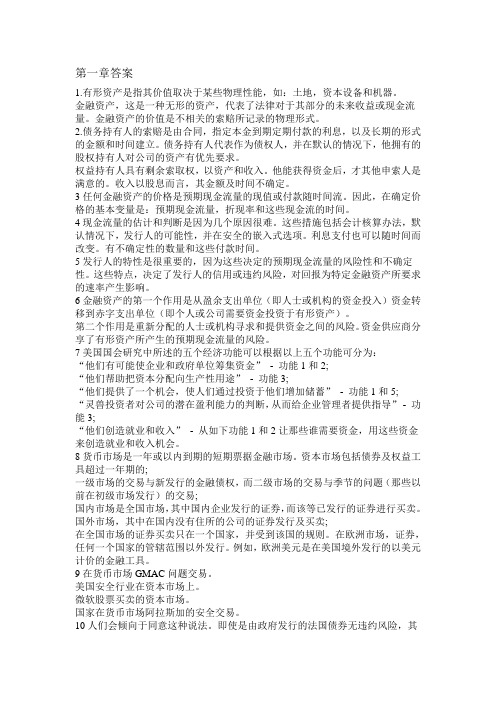
第一章答案1.有形资产是指其价值取决于某些物理性能,如:土地,资本设备和机器。
金融资产,这是一种无形的资产,代表了法律对于其部分的未来收益或现金流量。
金融资产的价值是不相关的索赔所记录的物理形式。
2.债务持有人的索赔是由合同,指定本金到期定期付款的利息,以及长期的形式的金额和时间建立。
债务持有人代表作为债权人,并在默认的情况下,他拥有的股权持有人对公司的资产有优先要求。
权益持有人具有剩余索取权,以资产和收入。
他能获得资金后,才其他申索人是满意的。
收入以股息而言,其金额及时间不确定。
3任何金融资产的价格是预期现金流量的现值或付款随时间流。
因此,在确定价格的基本变量是:预期现金流量,折现率和这些现金流的时间。
4现金流量的估计和判断是因为几个原因很难。
这些措施包括会计核算办法,默认情况下,发行人的可能性,并在安全的嵌入式选项。
利息支付也可以随时间而改变。
有不确定性的数量和这些付款时间。
5发行人的特性是很重要的,因为这些决定的预期现金流量的风险性和不确定性。
这些特点,决定了发行人的信用或违约风险,对回报为特定金融资产所要求的速率产生影响。
6金融资产的第一个作用是从盈余支出单位(即人士或机构的资金投入)资金转移到赤字支出单位(即个人或公司需要资金投资于有形资产)。
第二个作用是重新分配的人士或机构寻求和提供资金之间的风险。
资金供应商分享了有形资产所产生的预期现金流量的风险。
7美国国会研究中所述的五个经济功能可以根据以上五个功能可分为:“他们有可能使企业和政府单位筹集资金”- 功能1和2;“他们帮助把资本分配向生产性用途”- 功能3;“他们提供了一个机会,使人们通过投资于他们增加储蓄”- 功能1和5;“灵兽投资者对公司的潜在盈利能力的判断,从而给企业管理者提供指导”- 功能3;“他们创造就业和收入”- 从如下功能1和2让那些谁需要资金,用这些资金来创造就业和收入机会。
8货币市场是一年或以内到期的短期票据金融市场。
金融学课后习题答案(已打印)
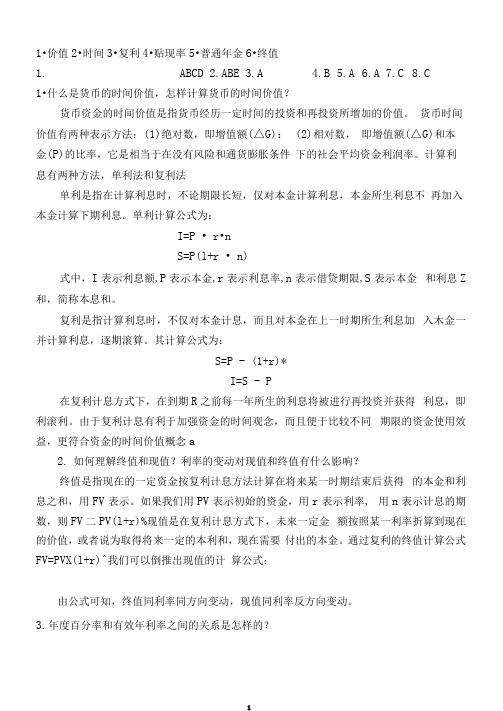
1•价值2•时间3•复利4•贴现率5•普通年金6•终值1.ABCD2.ABE3.A4.B5.A6.A7.C8.C 1•什么是货币的时间价值,怎样计算货币的时间价值?货币资金的时间价值是指货币经历一定时间的投资和再投资所增加的价值。
货币时间价值有两种表示方法:(1)绝对数,即增值额(△G): (2)相对数,即增值额(△G)和本金(P)的比率,它是相当于在没有风险和通货膨胀条件下的社会平均资金利润率。
计算利息有两种方法,单利法和复利法单利是指在计算利息时,不论期限长短,仅对本金计算利息,本金所生利息不再加入本金计算下期利息。
单利计算公式为:I=P • r•nS=P(l+r • n)式中,I表示利息额,P表示本金,r表示利息率,n表示借贷期限,S表示本金和利息Z 和,简称本息和。
复利是指计算利息时,不仅对本金计息,而且对本金在上一时期所生利息加入木金一并计算利息,逐期滚算。
其计算公式为:S=P - (1+r)*I=S - P在复利计息方式下,在到期R之前每一年所生的利息将被进行再投资并获得利息,即利滚利。
由于复利计息有利于加强资金的时间观念,而且便于比较不同期限的资金使用效益,更符合资金的时间价值概念a2.如何理解终值和现值?利率的变动对现值和终值有什么影响?终值是指现在的一定资金按复利计息方法计算在将来某一时期结束后获得的本金和利息之和,用FV表示。
如果我们用PV表示初始的资金,用r表示利率, 用n表示计息的期数,则FV二PV(l+r)%现值是在复利计息方式下,未來一定金额按照某一利率折算到现在的价值,或者说为取得将来一定的本利和,现在需要付出的本金。
通过复利的终值计算公式FV=PVX(l+r)^我们可以倒推出现值的计算公式:由公式可知,终值同利率同方向变动,现值同利率反方向变动。
3.年度百分率和有效年利率之间的关系是怎样的?年度百分比率(annual percent age rate, APR )是指银行等金融机构提供 的利率,也叫做报价利率。
《金融学》课后思考题参考答案

第一章货币与货币制度1.1 答案详解:A金银作为自然的产物,其只有在人类社会出现之后才作为货币,因此金银天然不是货币,B选项错误。
货币的本质是一般等价物,贝壳、铜在历史上都曾经做过货币,因此C选项错误。
金银只有在作为货币使用时才能作为一般等价物。
D选项也错误。
综合,A说法正确。
1.2 答案详解:A纸币是由国家发行的、强制使用的货币符号。
纸币的发行数量、面值等等都是由国家决定的,体现着一个国家的货币政策。
但是,货币的购买力不是由国家或者法律决定的,而是由货币发行数量和经济发展状况决定的。
如果生产力水平不变,社会生产出的总的商品数量不变,而流通中的货币数量为原来的两倍,那么商品的价格也会变成原来的两倍,此时每种面值的货币只代表原来一半的价值。
因此选A。
1.3 答案详解:ACEF在商品交换过程中,价值形式的发展经历的四个阶段有简单的价值形式、扩大的价值形式、一般价值形式、货币价值形式。
参见第一章第一节有关内容1.4 答案详解:银行券指由银行发行的以信用作为保证的可以兑现的银行票据,是以银行信用为担保所产生的一种信用工具银行券有其自身的发展历程。
开始时为安全的缘故,一些人将金银交由从事货币兑换业务的商铺保存,商铺则给客户开出相应收据,并承诺随时提取原有数量的金银;后来,由于交易和支付日益频繁,人们可以使用保管凭条进行直接收付,这就是银行券的雏形。
随着商业信用的不断扩大和发展,商业票据的运用范围日益广泛,但持票人只能到期才能兑现自己所持有的商业票据。
为了解决持票人临时需要资金的问题,银行进行金融创新,开展贴现业务,并且当银行的现款不足以支付持票人时,银行可以使用自己发行的银行券来支付。
1.5 答案详解:当货币在生活中日益重要时,一般说来,作为货币的商品有如下四个基本特征:一是价值比较高,这样可用较少的媒介完成较大量的商品交换;二是易于分割,一方面分割之后不会减少它的价值,另一方面分割成本较低,以便于同价值高低不等的商品交换;三是易于保存,即在保存过程中不会损失价值,费用很低;四是便于携带,以利于扩大化的商品交易。
- 1、下载文档前请自行甄别文档内容的完整性,平台不提供额外的编辑、内容补充、找答案等附加服务。
- 2、"仅部分预览"的文档,不可在线预览部分如存在完整性等问题,可反馈申请退款(可完整预览的文档不适用该条件!)。
- 3、如文档侵犯您的权益,请联系客服反馈,我们会尽快为您处理(人工客服工作时间:9:00-18:30)。
第三章5. Wine is more difficult to transport than gold and is also more perishable. Gold is thus a better store of value than wine and also leads to lower transactions cost. It is therefore a better candidate for use as money.10.Because of the rapid inflation in Brazil, the domestic currency, the real, is a poor store of value. Thus many people would rather hold dollars, which are a better store of value, and use them in their daily shopping.第四章4. The yield to maturity is less than 10 percent. Only if the interest rate was less than 10 percent would the present value of the payments add up to $4,000, which is more than the $3,000 present value in the previous problem.12.You would rather be holding long-term bonds because their price would increase more than the price of the short-term bonds, giving them a higher return.第五章7.In the loanable funds framework, when the economy booms, the demand for bonds increases: the public’s income and wealth rises while the supply of bonds also increases, because firms have more attractive investment opportunities. Both the supply and demand curves (B d and B s) shift to the right, but as is indicated in the text, the demand curve probably shifts less than the supply curve so the equilibrium interest rate rises. Similarly, when the economy enters a recession, both the supply and demand curves shift to the left, but the demand curve shifts less than the supply curve so that the interest rate falls. The conclusion is that interest rates rise during booms and fall during recessions: that is, interest rates are procyclical. The same answer is found with the liquidity preference framework. When the economy booms, the demand for money increases: people need more money to carry out an increased amount of transactions and also because their wealth has risen. The demand curve, M d, thus shifts to the right, raising the equilibrium interest rate. When the economy enters a recession, the demand for money falls and the demand curve shifts to the left, lowering the equilibrium interest rate. Again, interest rates are seen to be procyclical. 16.If the publi c believes the president’s program will be successful, interest rates will fall. The president’s announcement will lower expected inflation so that the expected return on goods decreases relative to bonds. The demand for bonds increases and the demand curve, B d, shifts to the right. For a given nominal interest rate, the lower expected inflation means that the real interest rate has risen, raising the cost of borrowing so that the supply of bonds falls. The resulting leftward shift of the supply curve, B s, and the rightward shift of the demand curve, B d, causes the equilibrium interest rate to fall.18.Interest rates will rise. The expected increase in stock prices raises the expected return on stocks relative to bonds and so the demand for bonds falls. The demand curve, B d, shifts to the left and the equilibrium interest rate rises.第六章3.During business cycle booms, fewer corporations go bankrupt and there is less default risk on corporate bonds, which lowers their risk premium. Similarly, during recessions, default risk on corporate bonds increases and their risk premium increases. The risk premium on corporate bonds is thus anticyclical, rising during recessions and falling during booms.7.(a) The yield to maturity would be 5 percent for a one-year bond, 5.5 percent for a two-year bond, 6 percent for a three-year bond, 6 percent for a four-year bond, and 5.8 percent for a five-year bond; (b) the yield to maturity would be 5 percent for a one-year bond, 4.5 percent for a two-year bond, 4 percent for a three-year bond, 4 percent for a four-year bond, and 4.2 percent for a five-year bond. The upward- and then downward-sloping yield curve in (a) would tend to be even more upward sloping if people preferred short-term bonds over long-term bonds because long-term bonds would then have a positive risk premium. The downward- and then upward-sloping yield curve in (b) also would tend to be more upward sloping because of the positive risk premium for long-term bonds.10.The reduction in income tax rates would make the tax-exempt privilege for municipal bonds less valuable,and they would be less desirable than taxable Treasury bonds.The resulting decline in the demand for municipal bonds and increase in demand for Treasury bonds would interest rates on municipal bonds while causing interest rates on Treasury bonds to fall.12.Lower brokerage commissions for corporate bonds would make them more liquid and thus increase their demand,which would lower their risk premium.第七章5.A stock market bubble can occur if market participants either believe that dividends will have rapid growth or if they substantially lower the required return on their equity investments, thus lowering the denominator in the Gordon model and thereby causing stock prices to climb. By raising interest rates the central bank can cause the required rate of return on equity to rise, thereby keeping stock prices from climbing as much. Also raising interest rates may help slow the expected growth rate of the economy and hence of dividends, thus also keeping stock prices from climbing.9.True, as an approximation. If large changes in a stock price could be predicted, then the optimal forecast of the stock return would not equal the equilibrium return for that stock. In this case, there would be unexploited profit opportunities in the market and expectations would not be rational. Very small changes in stock prices could be predictable, however, and the optimal forecast of returns would equal the equilibrium return. In this case, an unexploited profit opportunity would not exist.13.Probably not. Although your broker has done well in the past, efficient markets theory suggests that she has probably been lucky. Unless you believe that your broker has better information than the rest of the market, efficient markets theory indicates that you cannot expect the broker to beat the market in the future.第八章1.Financial intermediaries can take advantage of economies of scale and thus lower transactions costs. For example, mutual funds take advantage of lower commissions because the scale of their purchases is higher than for an individual, while banks’ large scale allows them to keep legal and computing costs per transaction low. Economies of scale which help financial intermediaries lower transactions costs explains why financial intermediaries exist and are so important to the economy.10.Ture.If the borrower turns out to be a bad credit risk and goes broke,the lender loses less,because the collateral can be sold to make up any losses on the loan.Thus adverse selection is not as severe a problem.11.The free-rider problem means that private producers of information will not obtain the full benefit of their information-producing activities, and so less information will be produced. This means that there will be less information collected to screen outgood from bad risks, making adverse selection problems worse, and that there will be less monitoring of borrowers, increasing the moral hazard problem.第九章5.The $50 million deposit outflow means that reserves fall by $50 million to $25 million. Since required reserves are $45 million (10 percent of the $450 million of deposits), your bank needs to acquire $20 million of reserves. You could obtain these reserves by either calling in or selling off $20 million of loans, by borrowing $20 million in discount loans from the Fed, by borrowing $20 million from other banks or corporations, by selling $20 million of securities, or by some combination of all of these.11.In order for a banker to reduce adverse selection she must screen out good from bad credit risks by learning all she can about potential borrowers. Similarly in order to minimize moral hazard, she must continually monitor borrowers to ensure that they are complying with restrictive loan covenants. Hence it pays for the banker to be nosy.第十四章3.The money supply fell sharply because when c rose,there was a shift from one component of the money supply(checkable deposits) with more multiple expansion to another (currency) with less.Overall multiple deposit expansion fell, leading to a decline in the monry supply.4.The rise in banks’ holdings of excess reserves relative to checkable deposits meant that the banking system in effect had fewer reserves to support checkable deposits. Thus the money multiplier fell and this led to a decline in the money supply.14.The increase in loan demand will cause interest rates to rise. The rise in interest rates increases the cost of holding excess reserves and the incentives to borrow from the Fed. Therefore, e falls, which increases the amount of reserves available to support checkable deposits, and the volume of discount loans increases, which raises the monetary base. The result is a higher money supply.第十五章2.When the public’s holding of currency increases, during Christmas, the currency–checkable deposits ratio increases and the money supply falls. To counteract this decline in the money supply, the Fed will conduct a defensive open market purchase.10.The costs are that banks that deserve to go out of business because of poor management may survive because of Fed discounting to prevent panics. This might lead to an inefficient banking system with many poorly run banks.。
